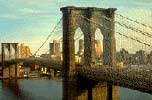The Brooklyn Bridge
A short Brooklyn Bridge History based on the Chronology by Barbara Head Millstein, the Brooklyn Bridge Exhibition 1983, Brooklyn Museum.
Barbara Mensch, 1950- Brooklyn Bridge, 1998 (silver-gelatin print)
1802 A petition to the State Legislature proposes constructing a bridge.
1857 A bill is proposed to the New York Legislature to build a suspension bridge over the East River to Brooklyn.
1865 John A. Roebling and Wilhelm Hildenbrand draw plans.
1866 A bill is passed by the New York State Legislature for construction.
April, 1867 The New York Bridge Company is incorporated.
May, 1867 The New York Bridge Company makes John A. Roebling engineer.
1869 President Ulysses S. Grant signs a bill approving the plan.
July, 1869 John A. Roebling 66, dies in an accident making observations to determine the exact location of the Brooklyn tower. His son, Washington Roebling, succeeds him.
January, 1870 Work begins.
May, 1871 The New York caisson is launched. Although the Brooklyn foundation hit bedrock at 44 feet, the foundation on the Manhattan end rests on sand at 78 feet.
1872 Roebling is stricken by caisson disease, (decompression sickness) during construction of the Manhattan caisson, 24 meters (78 feet) beneath the surface of New York's East River. This disease left Colonel Roebling paralyzed, partly blind, deaf, and mute. He supervises the building of the Bridge from his bedroom, his wife instructing the Bridge engineers. Emily Roebling became the surrogate Chief Engineer for the bridge between 1872 and its opening in 1883. To keep the bridge construction in the Roebling name, Emily Roebling continued the work of her husband. She learned higher math and engineering through "on-the-job" training.
1874 The Brooklyn Bridge is made public, repaying the subscribers with interest.
May, 1875 The Brooklyn tower is completed.
July, 1875 The New York tower is completed.
1877 A temporary footbridge between the towers is built.
1887 Scandal over the supply of faulty wire.
May 24,1883 The Brooklyn Bridge is opened
. During its construction twenty-seven men died,
including its designer, John A. Roebling.
During its construction twenty-seven men died,
including its designer, John A. Roebling.
[From http://www.lincoln-kent-bridges.com/Pages/brooklyn.html]
The Brooklyn Bridge is a suspension bridge that spans the East River from Brooklyn to Manhattan Island, New York City. The Brooklyn Bridge was the first bridge to use steel for cable wire, and during its construction explosives were used inside a pneumatic caisson for the first time. The masterwork of John Augustus Roebling, the Brooklyn Bridge was built (1869-83) in the face of immense difficulties. Roebling died as a result of an accident at the outset, and his son, Washington Roebling, taking over as chief engineer, suffered a crippling attack of caisson disease (the bends) during the founding of the New York pier (1872). Confined to his apartment in Columbia Heights (Brooklyn), he continued to direct operations, observing with field glasses and sending messages to the site by his wife, Emily Warren Roebling. A compressed-air blast that wrecked a pneumatic caisson slowed the work, as did a severe fire that smoldered for weeks in another caisson, a cable that parted from its anchorage on the Manhattan side and crashed into the river, and the fraud perpetrated by a steel-wire contractor that necessitated the replacement of tons of cable.
 Arthur Leipzig,
1918- Brooklyn Bridge, 1946 (silver-gelatin print)
From:http://www.afterimagegallery.com/brooklyn.htm
Arthur Leipzig,
1918- Brooklyn Bridge, 1946 (silver-gelatin print)
From:http://www.afterimagegallery.com/brooklyn.htm
The Brooklyn Bridge's 486-metre main span was the longest in the world until the completion of the Firth of Forth cantilever bridge in Scotland in 1890. Its deck, supported by four cables, carries both automobile and pedestrian traffic. A distinctive feature is the broad promenade above the roadway, which John Roebling accurately predicted "in a crowded commercial city will be of incalculable value."